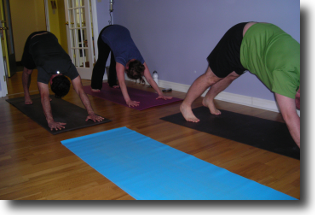Alice was heading down the hall towards the yoga studio with her yoga mat over her shoulder.
She tried the first practice space but it was too big and empty. She went to the second space but it was too small and hot. She did not know anyone in the room. Finally she went to the last practice space. It was a comfortable size, the temperature was to her liking and she knew most of the people there.
After saying hi to a few of her friends she took her yoga mat off her shoulder and before she rolled it out on the floor she mentally reviewed what she had learned from the Yoga Etiquette book.
Alice learned three things about yoga mats from the Yoga Etiquette book.
- Place your mat gently on the floor
- Respect your neighbour’s space
- Clean up your mat and the space around you at the end of the class.
Let’s look at each of these in turn starting with the first one – Place your mat gently on the floor.
Place your mat gently on the floor
You do not want to flap your mat out like a bed sheet and slap it down on the floor. When you do this several things happen.
You create a breeze when you flap your mat out. This breeze can disturb the other students in the class. The breeze can also blow dust and dirt in to peoples faces and lastly the breeze can cool them off and make them uncomfortable.
When the mat hits the floor it will make a loud noise that will disturb everyone in the room. It will make them jump and disrupt their concentration.
The best approach here is to place your mat on the floor and then roll it out from there.
Now lets move on to the next point – do not crowd your neighbours.
Respect your neighbour’s space
Different styles of yoga require different amounts of space between you and your neighbour.
Kripalu yoga uses a lot of props and you will need room for the props next to your mat when they are not in use. You need to be sure to leave lots of space between your mat and your neighbour’s mat if you are in a Kripalu yoga class.
Ashtanga yoga uses almost no props at all. Ashtanga yogis are used to having their mats very close to each other and they tend to stay within the boundary of their mat.
If you are in an Ashtanga yoga class you can put your mat within inches of your neighbours if the room is crowded and no one will mind. In fact they will think that it is quite normal.
Once you know what is the customary spacing of yoga mats for the style of yoga that you are practicing you will know how far away to place your mat from your neighbour’s mat.
And finally let us look at what to do with your mat after the class is over.
Clean up after class
Once the class is over you need to clean up your mat and the space around your mat.
If you sweat a lot during class, you need to clean the floor and your mat. Usually the studio will provide small towels for this job or you can bring your own. Leaving puddles of water on the floor is a safety hazard.
If you have borrowed a yoga mat from the studio you should always throughly clean it after you have used it and before you return it to the storage area.
If you have your own mat it is up to you if you want to clean it. Cleaning your mat after each use will keep it smelling fresh for a very long time.
After you have cleaned and dried your mat you need to roll it up and get it ready to take home.
Summary
Alice learned from the Yoga Etiquette book that you should
- Place your mat quietly on the floor
- Keep the appropriate space between you and your neighbour
- Clean your mat after class.
After class, Alice rolled up her mat, placed it on her shoulder and left the studio. She was thinking about how great the class was and how soon she could come back for her next yoga class.
Next Steps
If you found these yoga etiquette tips useful you should get the Yoga Etiquette book.




